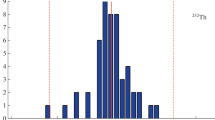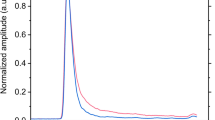Abstract
In airborne gamma ray spectrum processing, different analysis methods, technical requirements, analysis models, and calculation methods need to be established. To meet the engineering practice requirements of airborne gamma-ray measurements and improve computational efficiency, an improved shuffled frog leaping algorithm–particle swarm optimization convolutional neural network (SFLA-PSO CNN) for large-sample quantitative analysis of airborne gamma-ray spectra is proposed herein. This method was used to train the weight of the neural network, optimize the structure of the network, delete redundant connections, and enable the neural network to acquire the capability of quantitative spectrum processing. In full-spectrum data processing, this method can perform the functions of energy spectrum peak searching and peak area calculations. After network training, the mean SNR and RMSE of the spectral lines were 31.27 and 2.75, respectively, satisfying the demand for noise reduction. To test the processing ability of the algorithm in large samples of airborne gamma spectra, this study considered the measured data from the Saihangaobi survey area as an example to conduct data spectral analysis. The results show that calculation of the single-peak area takes only 0.13 ~ 0.15 ms, and the average relative errors of the peak area in the U, Th, and K spectra are 3.11, 9.50, and 6.18%, indicating the high processing efficiency and accuracy of this algorithm. The performance of the model can be further improved by optimizing related parameters, but it can already meet the requirements of practical engineering measurement. This study provides a new idea for the full-spectrum processing of airborne gamma rays.









Similar content being viewed by others
Data Availability
The data that support the findings of this study are openly available in Science Data Bank at https://www.doi.org/10.57760/sciencedb.j00186.00121 and https://cstr.cn/31253.11.sciencedb.j00186.00121
References
International Atomic Energy Agency, Airborne gamma ray spectrometer surveying (Technical Reports Series No. 323) (International Atomic Energy Agency, Vienna, 1991)
J.H. Wan, S.Q. Xiong, Z.G. Fan, Technical status and prospect of airborne gamma spectrometry measurement. Geophys. Geochem. Explor. 36, 386–391 (2012). https://doi.org/10.11720/wtyht.2012.3.12 (in Chinese)
Z.L. Xu, Q.M. Meng, W.J. Li et al., Data processing software system of airborne geophysical exploration based on Oasis Montaj platform. Comput. Tech. Geophys. Geochem. Explor. 36, 257–261 (2014). https://doi.org/10.3969/j.issn.1001-1749.2014.03.01 (in Chinese)
L.F. Wang, D.J. Xue, H. He et al., Application of plug-in technology in GeoProbe geophysical software platform. Geophys. Geochem. Explor. 37, 547–551 (2013). https://doi.org/10.11720/j.issn.1000-8918.2013.3.32 (in Chinese)
P. Wang, L.J. Dai, Methods and Applications of airborne gamma spectrometry data processing. Proceedings of the Eighth Annual Conference of the Chinese Geophysical Society in 1992, Kunming, 10–14 November 1992. (in Chinese)
Y.F. Guo, A.G. Ji, Z.H. Zhang, et al., Gamma energy spectrum processing technology research. Pet. Geol. Oilfield Dev. Daqing 12, 56–60 (1993). https://doi.org/10.19597/j.issn.1000-3754.1993.02.015 (in Chinese)
P.H. Hendriks, J. Limburg, R.J.D. Meijer, Full-spectrum analysis of natural g-ray spectra. J. Environ. Radioactiv. 53, 365–380 (2001). https://doi.org/10.1016/S0265-931X(00)00142-9
Y.F. Guo, Smoothing and filtering of natural gamma spectrum. J. Northeast Pet. Univ. 03, 113–114 (2003). (in Chinese)
W.C. Ni, Theoretical study on the analysis method of airborne gamma-ray ful energy spectrum data. Uranium Geol. 27, 231–241 (2011). (in Chinese)
Y. Gu, K. Sun, L.Q. Ge et al., Investigating the minimum detectable activity concentration and contributing factors in airborne gamma-ray spectrometry. Nucl. Sci. Tech. 32, 110 (2021). https://doi.org/10.1007/s41365-021-00951-6
Y. Jin, Y. Guo, Y.X. Meng, Energy spectrum data processing and spectrum solving method based on full spectrum. Electron. Tech. Software Eng. 08, 164 (2018). (in Chinese)
R.K. Gu, Z.R. Hou, E.S. Shen et al., Airborne monitoring of radioactivity level in the regions surrounding Qinshan nuclear power plant and Shanghai Radiation Protection. Radiat. Prot. 17, 167–187 (1997). (in Chinese)
Z.Q. Pan, Compilation of papers from the Fourth National Symposium on Nuclear Emergency Preparednes. Beijing: Papers from the fourth national symposium on nuclear emergency preparednes 639–647 (2006). (in Chinese)
W.C. Ni, R.K. Gu, Airborne monitoring method of nuclear emergency. Uranium Geol. 19, 366–373 (2003). (in Chinese)
Z.R. Hou, R.K. Gu, J.J. Li, Application of aerospace technology in nuclear accident emergency and environmental assessment. Proc Baotou Geophys Geochem Conf 1, 88–94 (1996). (in Chinese)
W.C. Ni, Airborne selective gamma ray exploration. World Nucl. Geosci. 14, 344–351 (1997). (in Chinese)
Q.S. Liu, Q.X. Zhang, H. Yang, et al., Research on terrain correction method of airborne γ spectrometry. Nucl. Tech. 44, 090503 (2021). https://doi.org/10.11889/j.0253-3219.2021.hjs.44.090503 (in Chinese)
C. Xiong, K. Sun, L.Q. Ge, et al., A method for the identification of ore-caused anomalies information in the airborne γ-ray spectrum based on fractal filtering by layer. Nucl. Tech. 42, 010201 (2019). https://doi.org/10.11889/j.0253-3219.2019.hjs.42.010201 (in Chinese)
L.Q. Ge, G.Q. Zeng, W.C. Lai et al., The development of a digital airborne gamma-ray spectrometry. Nucl. Tech. 34, 156–160 (2011). (in Chinese)
J.W. Shao, L. Bai, L.X. He, Development of gamma spectrum processing software. Annu. R. China I. Atom. Energ. 00, 223 (2012). (in Chinese)
G. Lasche, R. Coldwell, R. Metzger, VRF (“Visual RobFit”) – nuclear spectral analysis with nonlinear full-spectrum nuclide shape fitting. EPJ Web Conf. 153, 1–6 (2017). https://doi.org/10.1051/epjconf/201715301002
C.Y. Feng, H.B. Wang, Z.Y. Zhou et al., Application research of airborne gamma full spectrum analysis method based on python programming. World Nucl. Geosci. 39, 280–288 (2022). https://doi.org/10.3969/j.issn.1672-0636.2022.02.011 (in Chinese)
L.Y. Zhou, H. Zha, J.R. Shi et al., A non-invasive diagnostic method of cavity detuning based on a convolutional neural network. Nucl. Sci. Tech. 33, 94 (2022). https://doi.org/10.1007/s41365-022-01069-z
J.Q. Jin, C.C. Yu, L. Shi et al., Review on integration technology of foreign airborne geophysical exploration systems (2015–2020). Geophys. Geochem. Explor. 46, 285–295 (2022). (in Chinese)
Y.J. Yao, Based on a large sample of gamma ray bursts delay spectrum research, Hebei normal university, 2021
H.B. Gao, L. Gao, C. Zhou et al., Research on neural network training algorithm based on particle swarm optimization. Acta Electron. Sin. 32, 1572–1574 (2004). (in Chinese)
T. Yang, H.Y. Zhou, L.T. Guan, Adaptive wavelet Threshold denoising method for vibration Suppression. Acta Sci. Nat. Univ. Sunyatseni 44, 15–19 (2005). (in Chinese)
L. Zhang, H.F. Qin, C.B. Yu, Research on denoising algorithm based on wavelet threshold. Comput. Eng. Appl. 09, 172–173 (2008). (in Chinese)
D.L. Donoho, I.M. Johnstone, Ideal spatial adaptation by wavelet shrinkage. Biometrika 81, 425–455 (1994). https://doi.org/10.1093/biomet/81.3.425
K. Sun, C. Xiong, L.Q. Ge, et al., Method of line element correction for airborne γ spectrum anomaly information based on wavelet transform. Nucl. Tech. 41, 100501 (2018). https://doi.org/10.11889/j.0253-3219.2018.hjs.41.100501 (in Chinese)
T. Lin, Y.H. Mi, M.P. Yang et al., Research on airborne gamma spectrum data denoising method based on VMD-wavelet threshold. Geo. Review 67, 199–200 (2021). https://doi.org/10.16509/j.georeview.2021.s1.088 (in Chinese)
F. Li, W.T. Guo, X.T. Deng et al., A hybrid shuffled frog leaping algorithm and its performance assessment in multi-dimensional symmetric function. Symmetry 14, 131 (2022). https://doi.org/10.3390/sym14010131
M.S. El, Mohamed, Advanced algorithms for retrieving pileup peaks of digital alpha spectroscopy using antlions and particle swarm optimizations. Nucl. Sci. Tech. 31, 37 (2020). https://doi.org/10.1007/s41365-020-0745-5
S. Li, L.J. Liu, M. Zhai, Short-term traffic flow prediction based on BP neural network based on improved particle swarm optimization. Syst. Eng. Theory Pract. 32, 2045–2049 (2012). https://doi.org/10.12011/1000-6788(2012)9-2045 (in Chinese)
Q. Long, Y.Q. Liu, Y.P. Yang, Wind turbine gearbox fault diagnosis method based on particle swarm optimization BP neural network. Acta Energ. Sol. Sin. 33, 120–125 (2012). (in Chinese)
W.H. Zhou, Research on hidden layer structure and parameter optimization of RBF neural network. East China University of Science and Technology, 2014 (in Chinese)
Y.J. Zhang, P.J. Jin, X.H. Fu et al., Feature extraction of multi-modal brillouin scattering spectra based on Fla-LSSVM algorithm. Chin. J. Lasers 45, 227–234 (2018). https://doi.org/10.3788/CJL201845.0106004 (in Chinese)
L.Q. Ge, S.Q. Xiong, G.Q. Zeng et al., Airborne Gamma Spectrum Detection Technology and Application (Science Press, Beijing, 2016). (in Chinese)
J.F. Pang, γ Spectrum data analysis. (Shaanxi Science and Technology Press, Xi 'an, 1990). (in Chinese)
S. Kayalvili, M. Selvam, Hybrid SFLA-GA algorithm for an optimal resource allocation in cloud. Cluster Comput. 22, 3165 (2019). https://doi.org/10.1007/s10586-018-2011-8
B.R.S. Minty, Airborne gamma-ray spectrometric background estimation using full spectrum analysis. Geophysics 57, 279–287 (1992)
F. Li, C.F. Tang, H. Li et al., A LLS operator based S-I WT de-noising algorithm applied in EDXRF. X-ray Spectrom. 52, 13–21 (2023). https://doi.org/10.1002/xrs.3159
Acknowledgements
We thank the Sichuan Provincial Key Laboratory of Applied Nuclear Techniques in Geosciences and CDUT Team 203 for their English language review. We thank Professors Liang-Quan Ge, David Cohen, Sheng-Qing Xiong, and Si-Chun Zhou for their support.
Author information
Authors and Affiliations
Contributions
All authors contributed to the study conception and design. The algorithm proposal and verification, raw data, and analysis were performed by Fei Li, Xiao-Fei Huang, Bing-Hai Li, Feng Cheng, Guo-Qiang Zeng and Mu-Hao Zhang. The first draft of the manuscript was written by Fei Li, Xiao-Fei Huang, Yue-Lu Chen, and Tang Wang, and all authors commented on the previous versions of the manuscript. All the authors have read and approved the final version of the manuscript.
Corresponding authors
Ethics declarations
Conflict of interest
The authors declare that they have no competing interests.
Additional information
This work was supported by the National Natural Science Foundation of China (No. 42127807), Natural Science Foundation of Sichuan Province (Nos. 23NSFSCC0116 and 2022NSFSC12333), and the Nuclear Energy Development Project (No. [2021]-88).
Rights and permissions
Springer Nature or its licensor (e.g. a society or other partner) holds exclusive rights to this article under a publishing agreement with the author(s) or other rightsholder(s); author self-archiving of the accepted manuscript version of this article is solely governed by the terms of such publishing agreement and applicable law.
About this article
Cite this article
Li, F., Huang, XF., Chen, YL. et al. Quantitative algorithm for airborne gamma spectrum of large sample based on improved shuffled frog leaping–particle swarm optimization convolutional neural network. NUCL SCI TECH 34, 112 (2023). https://doi.org/10.1007/s41365-023-01265-5
Received:
Revised:
Accepted:
Published:
DOI: https://doi.org/10.1007/s41365-023-01265-5




